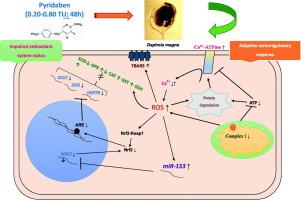Pyridaben-induced biochemical and molecular stress in Daphnia magna
IF 4.3
3区 环境科学与生态学
Q2 BIOCHEMISTRY & MOLECULAR BIOLOGY
Comparative Biochemistry and Physiology C-toxicology & Pharmacology
Pub Date : 2025-09-08
DOI:10.1016/j.cbpc.2025.110350
引用次数: 0
Abstract
Pyridaben (PDB) is a widely used acaricide in agriculture, classified as highly toxic to aquatic life (H400, H410; USEPA) because it inhibits mitochondrial complex I. This study aimed to evaluate the subacute toxicity of PDB (0.20–0.80 TU for 48 h) in the model organism Daphnia magna using an integrated molecular and biochemical multi-biomarker approach. To the best of our knowledge, this is the first comprehensive study to integrate molecular and biochemical markers related to oxidative stress and osmoregulation in assessing subacute PDB toxicity in D. magna using the Integrated Biomarker Response index (IBR). PDB exposure altered antioxidant system dynamics, with decreased SOD and GPX activities, increased CAT and GST activities, and elevated GSH and TBARS levels. The increase in Ca2+-ATPase activity was positively correlated with antioxidant enzymes, suggesting an adaptive osmoregulatory response to oxidative stress. Reduced total protein levels were negatively correlated with most of the biomarkers. At the molecular level, while the expression of oxidative stress-related genes decreased, miR-153 was significantly upregulated, showing a negative correlation with these genes but a positive correlation with other biomarker levels. The results revealed significant and interrelated alterations at both biochemical and molecular levels, and IBR analysis demonstrated that responses were notably triggered at 0.35 TU, with maximal effects observed at concentrations of 0.50 TU and above. These findings provide new insights into the ecological risk of PDB, supporting the use of multi-biomarker approaches for environmental monitoring, as well as elucidating molecular pathways underlying the adaptive responses of aquatic organisms to stress.

吡嘧虫酯诱导的水蚤生化和分子应激。
嘧达宾(Pyridaben, PDB)是一种广泛应用于农业的杀螨剂,因其抑制线粒体复合体i而被列为对水生生物的高毒性(H400, H410; USEPA)。本研究旨在利用综合分子和生化多生物标志物方法评估PDB (0.20-0.80 TU / 48 h)对模式生物大水蚤的亚急性毒性。据我们所知,这是第一个综合氧化应激和渗透调节相关的分子和生化标志物,利用综合生物标志物反应指数(IBR)评估D. magna亚急性PDB毒性的综合研究。PDB暴露改变了抗氧化系统动力学,SOD和GPX活性降低,CAT和GST活性增加,GSH和TBARS水平升高。Ca2+- atp酶活性的增加与抗氧化酶正相关,提示对氧化应激的适应性渗透调节反应。总蛋白水平的降低与大多数生物标志物呈负相关。在分子水平上,miR-153在氧化应激相关基因表达降低的同时显著上调,与这些基因呈负相关,而与其他生物标志物水平呈正相关。结果显示,在生化和分子水平上发生了显著且相互关联的变化,IBR分析表明,在0.35 TU时引起的反应明显,在0.50 TU及以上浓度时观察到的效果最大。这些发现为PDB的生态风险提供了新的见解,支持使用多生物标志物方法进行环境监测,并阐明了水生生物对胁迫的适应性反应的分子途径。
本文章由计算机程序翻译,如有差异,请以英文原文为准。
求助全文
约1分钟内获得全文
求助全文
来源期刊
CiteScore
7.50
自引率
5.10%
发文量
206
审稿时长
30 days
期刊介绍:
Part C: Toxicology and Pharmacology. This journal is concerned with chemical and drug action at different levels of organization, biotransformation of xenobiotics, mechanisms of toxicity, including reactive oxygen species and carcinogenesis, endocrine disruptors, natural products chemistry, and signal transduction with a molecular approach to these fields.

 求助内容:
求助内容: 应助结果提醒方式:
应助结果提醒方式:


